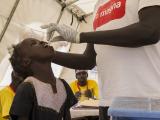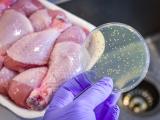The US Department of Agriculture (USDA) cut corners in evaluating pilot projects that were used in developing a proposal to streamline the agency's food safety inspection systems in poultry processing plants, according to the US Government Accountability Office (GAO).
Under the proposal, unveiled in 2012, USDA inspectors would spend less time visually inspecting poultry carcasses and more time focusing on other safety variables, with the aim of saving money and improving food safety. But the plan, which would allow faster production line speeds, has drawn objections from many health, labor, and consumer groups.
The plan, called the HACCP Based Inspection Models Project (HIMP), would largely transfer the work of inspecting carcasses from USDA Food Safety and Inspection Service workers to industry employees. When the proposal was announced, the agency estimated it would prevent up to 5,200 illnesses annually and reduce poultry production costs by at least $256 million per year. The meat industry supports the approach.
The USDA launched three pilot projects in 1998 at slaughter facilities for young chickens, turkeys, and hogs, the GAO report explains. Under the projects, company workers sort carcasses before USDA inspections.
The GAO said the USDA "has not thoroughly evaluated the performance of each of the pilot projects over time even though the agency stated it would do so when it announced the pilot projects."
For example, in a 2011 report on the pilot project at 20 chicken processing plants, the USDA said an inspection system based on the project would ensure food safety and quality levels as good as or better than those in plants not in the pilot project. But the evaluation was based on "snapshots of data for two two-year periods" instead of the whole record of the project, which is more than 10 years old, the GAO said.
In addition, the USDA did not evaluate the pilot project at five turkey plants and has no plans to do so, the agency said. Despite this, the department has presented a proposed rule spelling out an optional new poultry inspection system as being based on the USDA's experience in both chicken and turkey facilities, according to the report.
The GAO also said the department has begun writing a report on the pilot project at young hog plants, using analyses like those used in the report on the chicken plants, which suggest that similar limitations may apply.
In other assertions, the GAO said comments from 11 key stakeholder groups revealed both strengths and weaknesses in the three pilot projects. The strengths, it said, include "giving plants responsibility and flexibility for ensuring food safety and quality and allowing USDA inspectors to focus more on food safety activities."
As for weaknesses, the pilot projects don't require training of plant personnel for sorting carcasses, and faster line speeds raise concerns about both food safety and worker safety, the GAO said.
The report also asserts that the USDA did not disclose certain limitations in the information it used in its cost-benefit analysis supporting the proposal to change the poultry inspection approach. One is that the department gathered no cost information from turkey plants involved in the project.
The GAO is recommending that the USDA "collect and analyze information to determine if the young hog pilot project is meeting its purpose" and that it clearly disclose the deficiencies in the information it relied on for the proposal to modernize poultry inspections.
"USDA concurred with GAO's recommendations," the report states.
See also:
GAO report highlights, with link to full report
Jan 20, 2012, CIDRAP News story on USDA proposal
Related Sep 20, 2012, CIDRAP News item


















